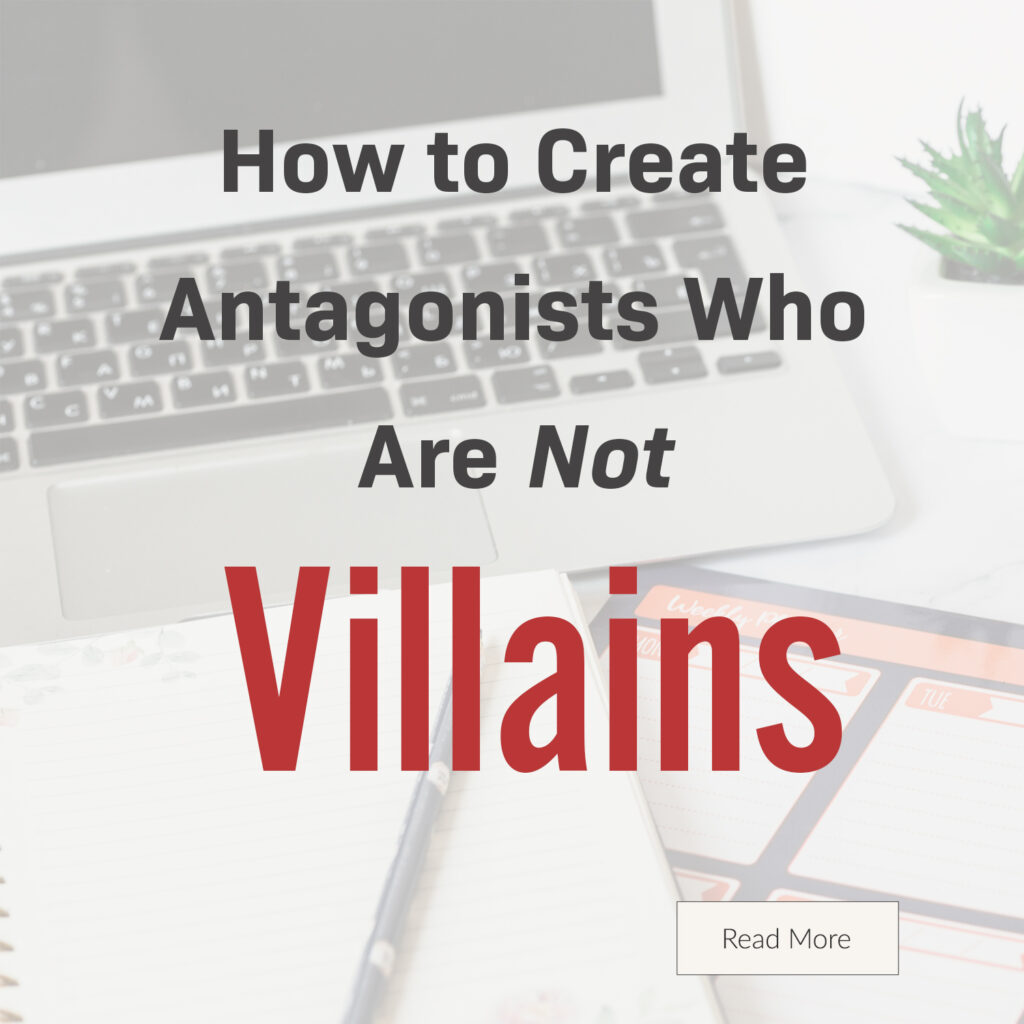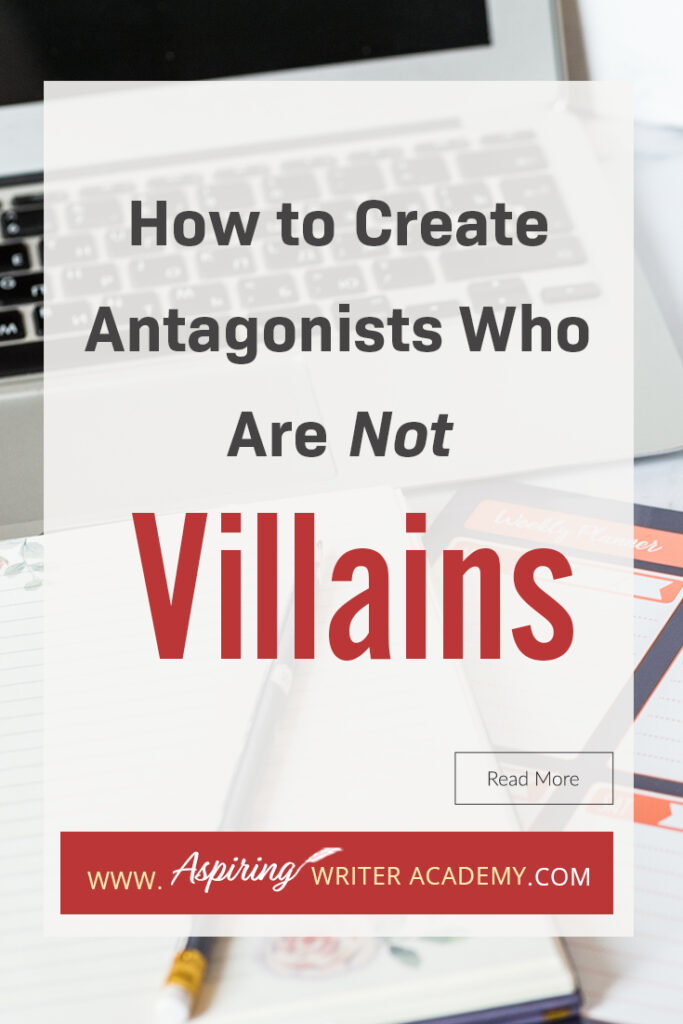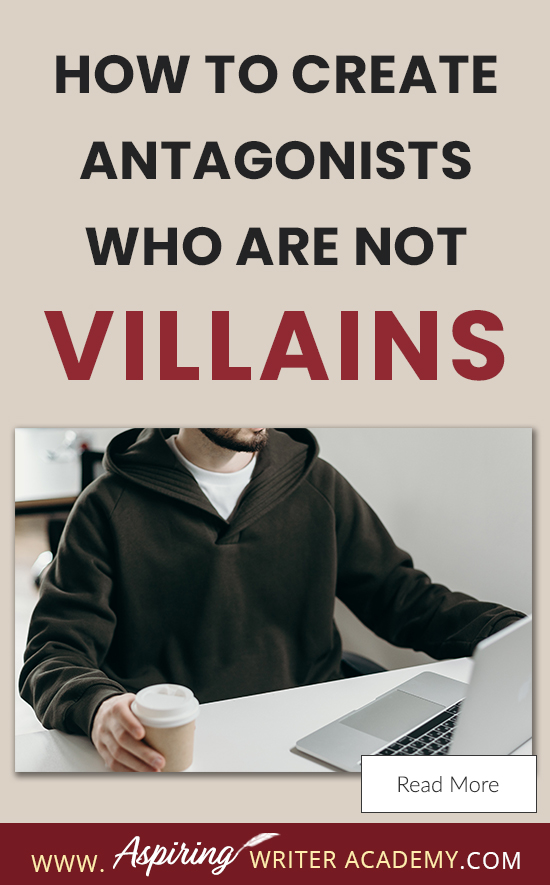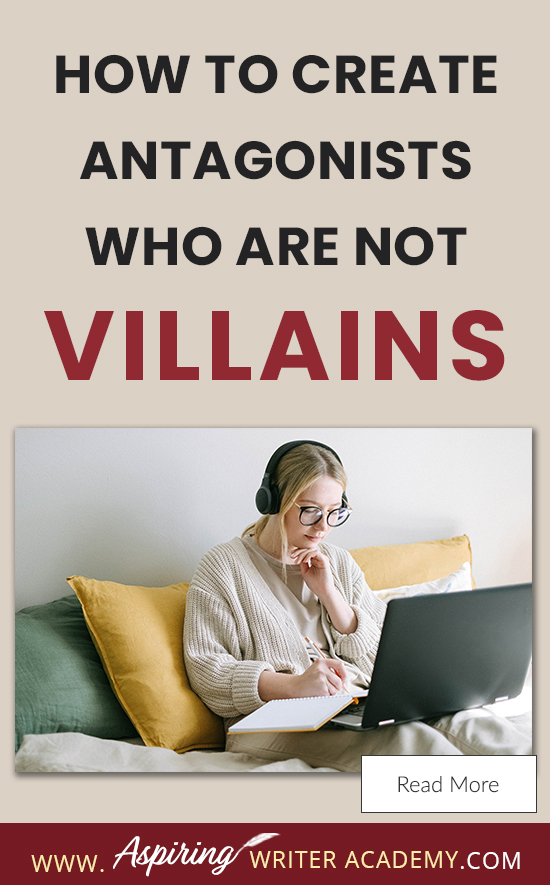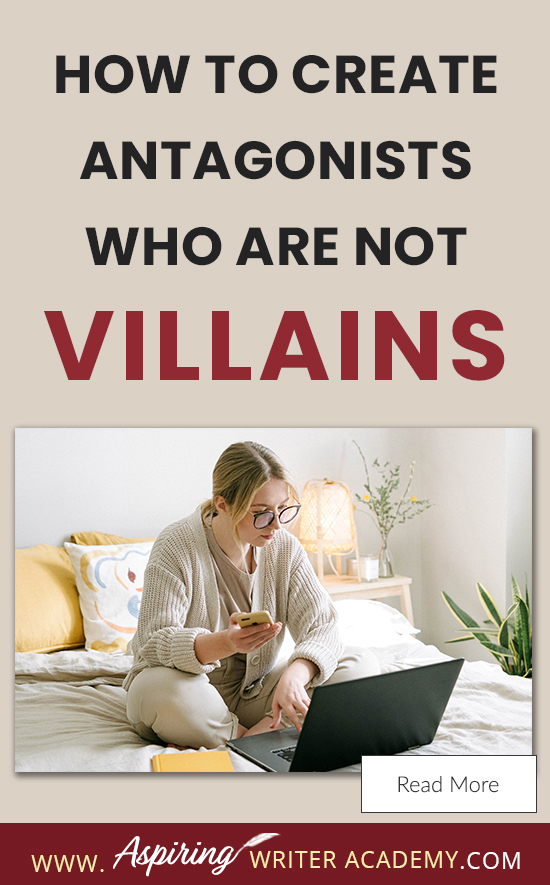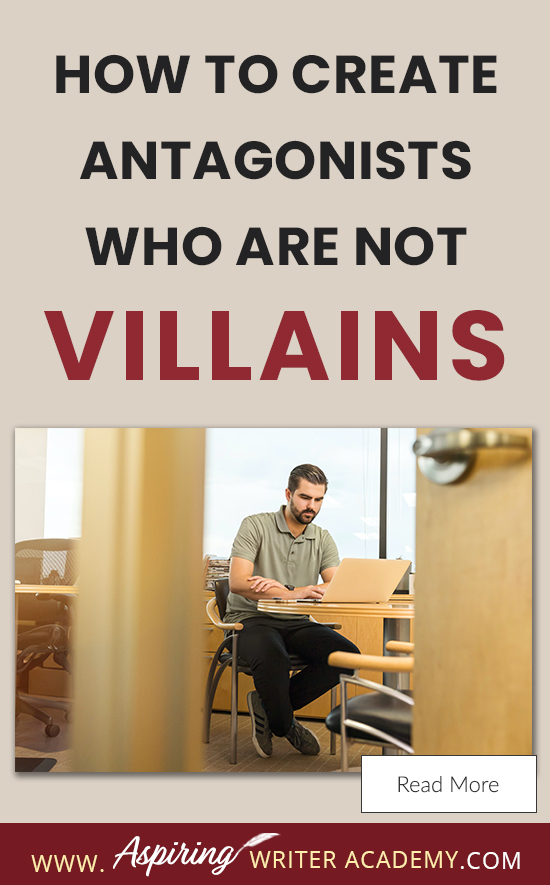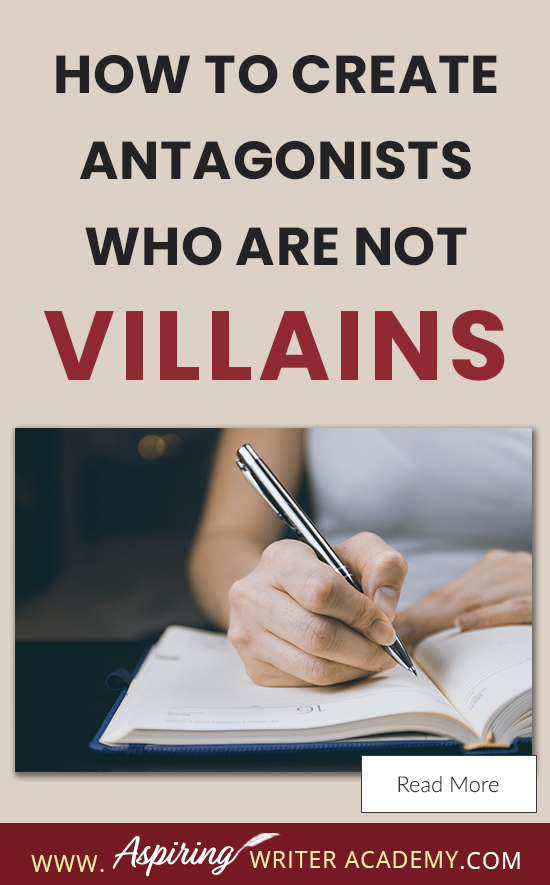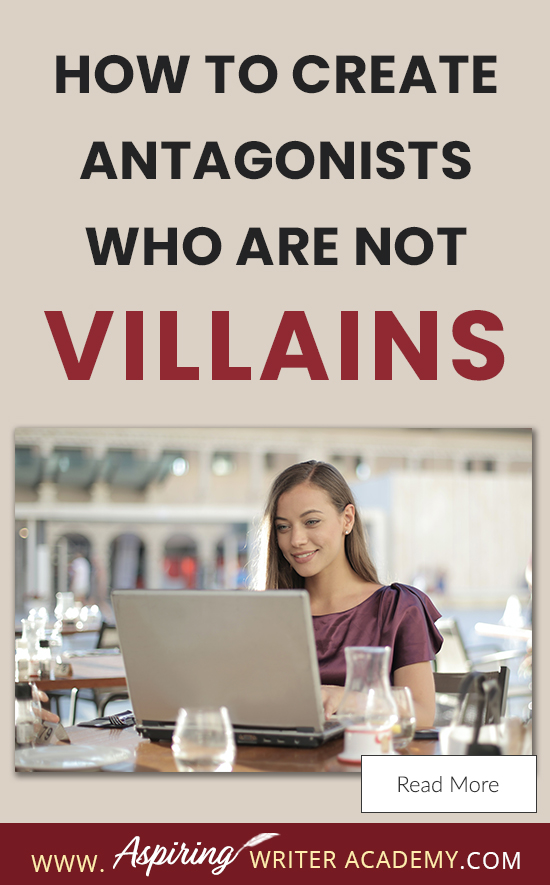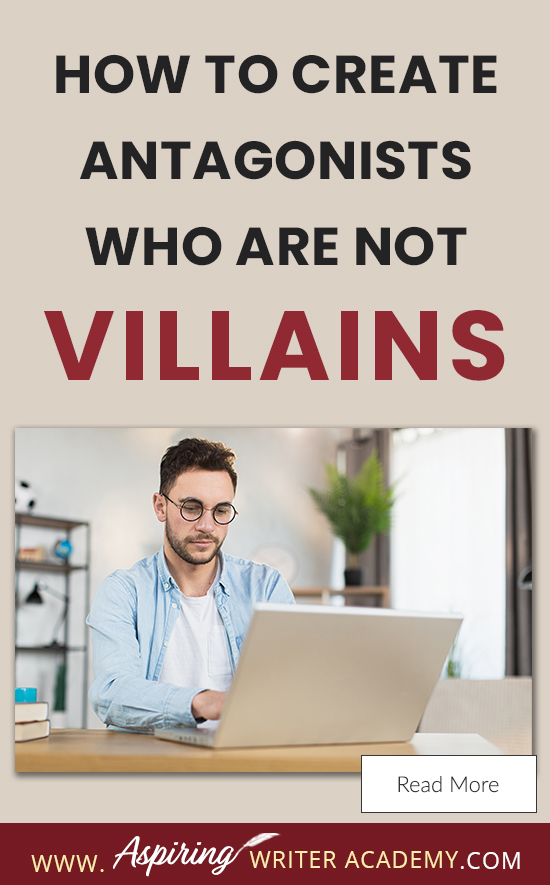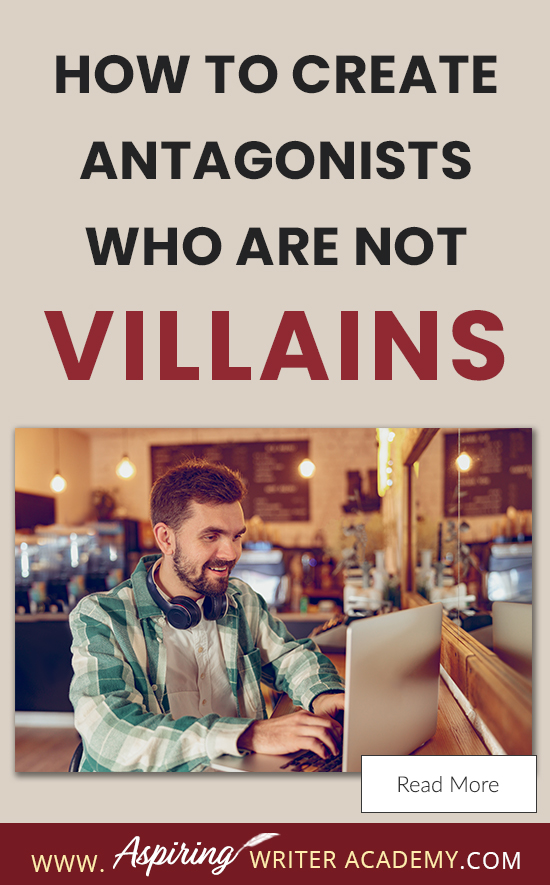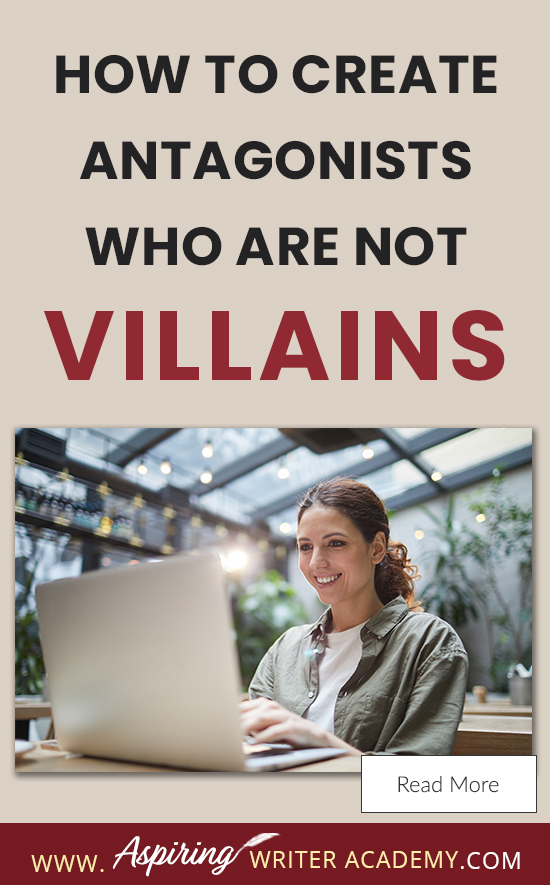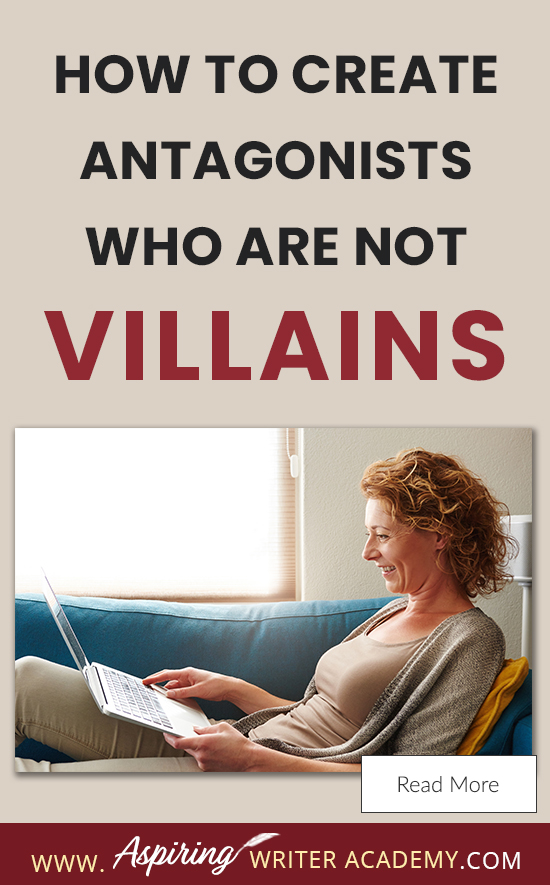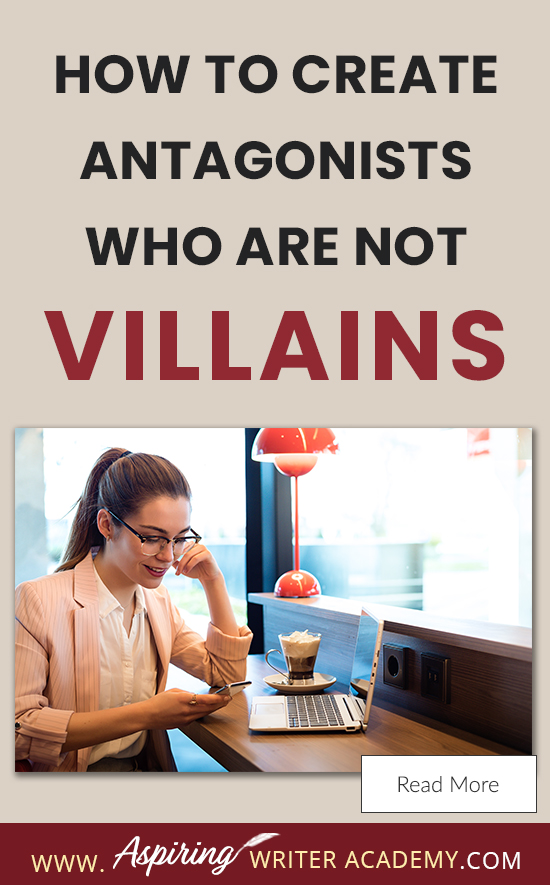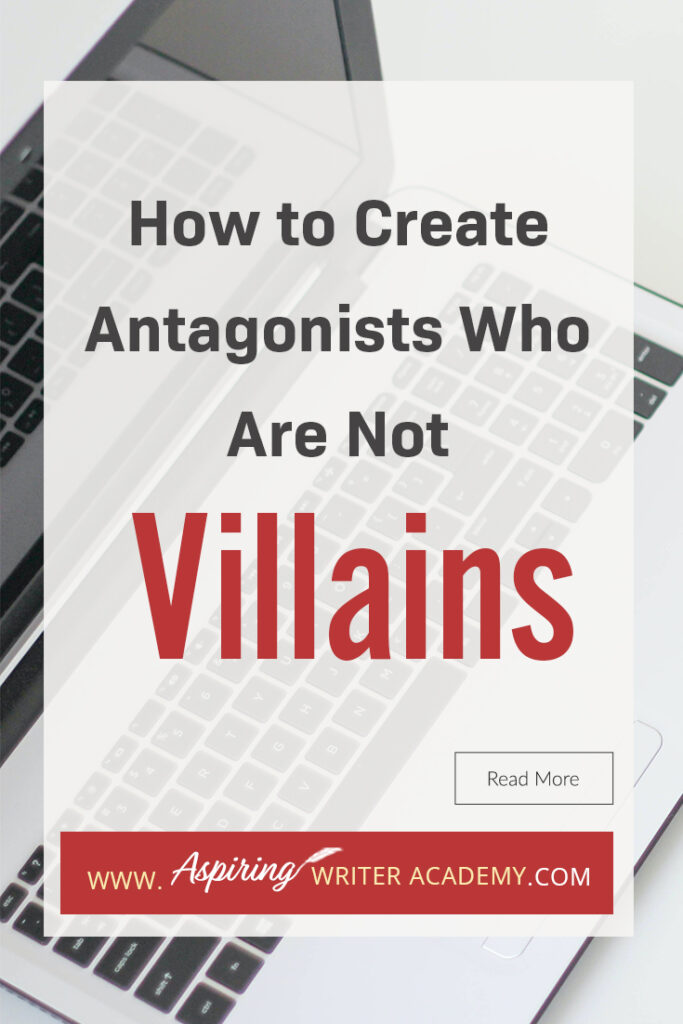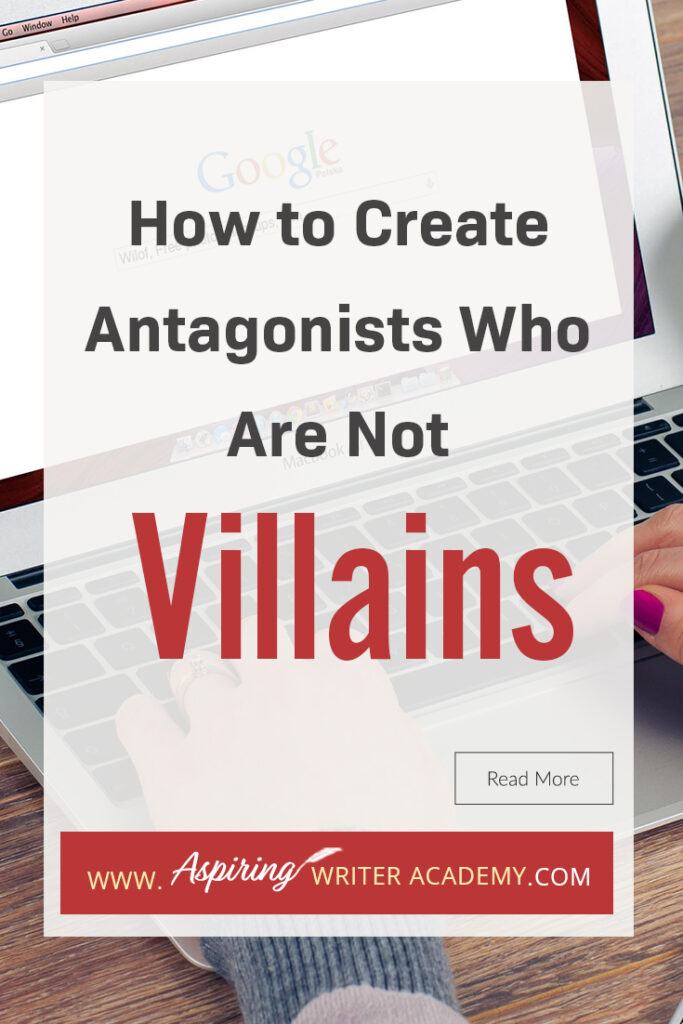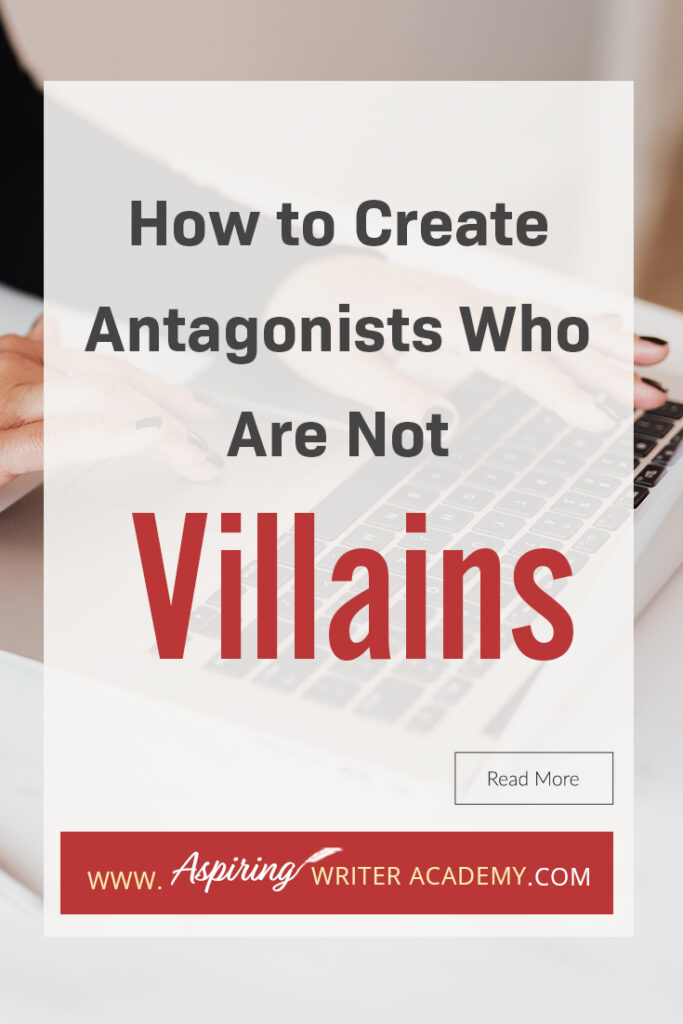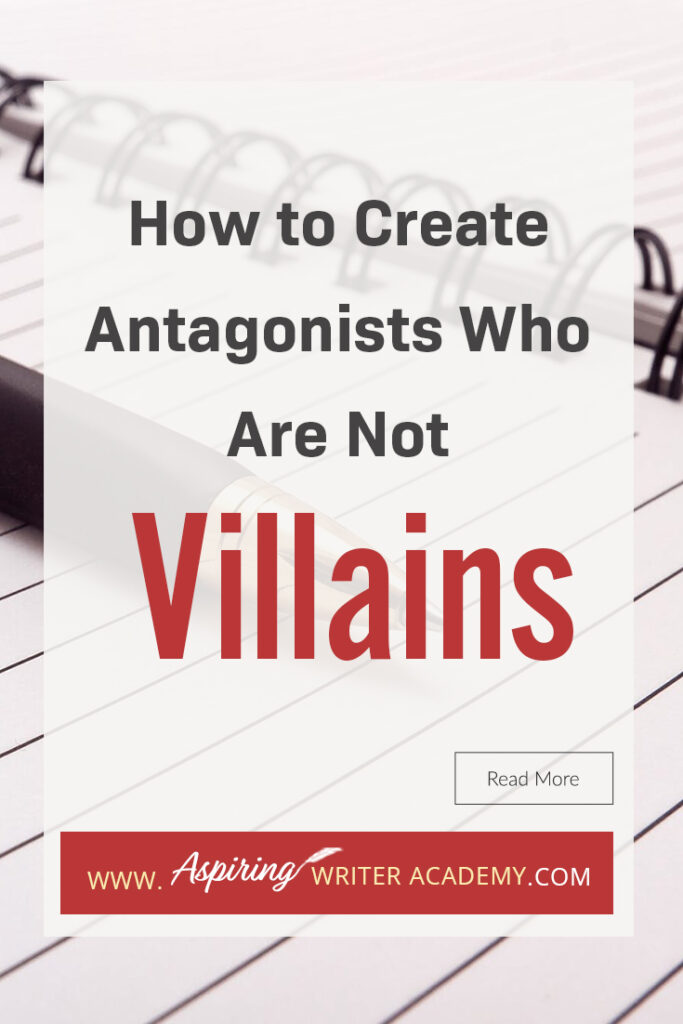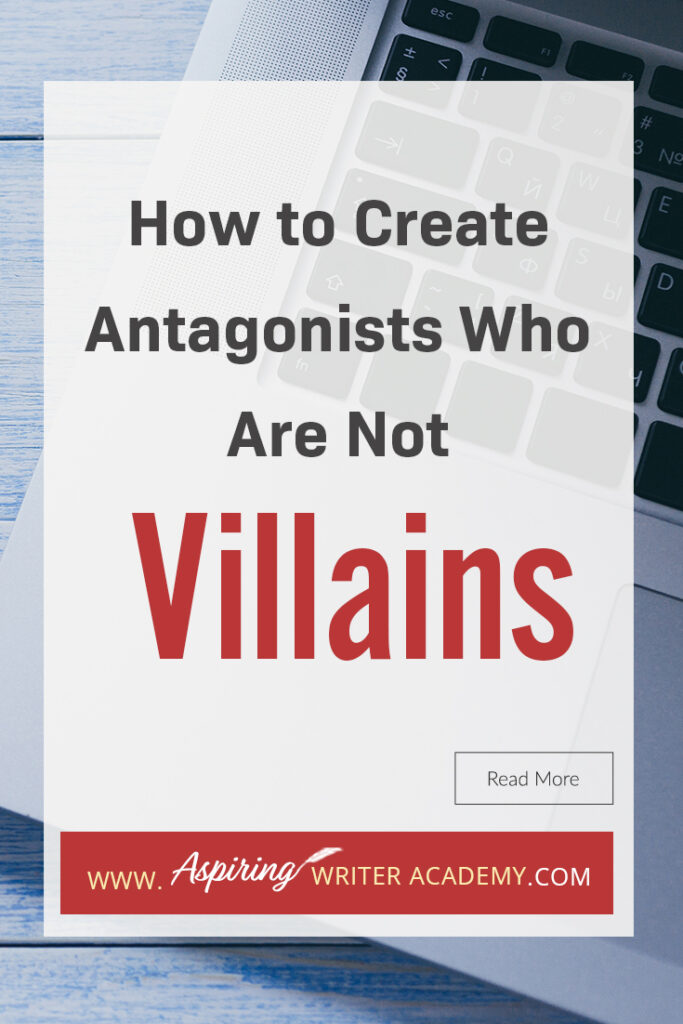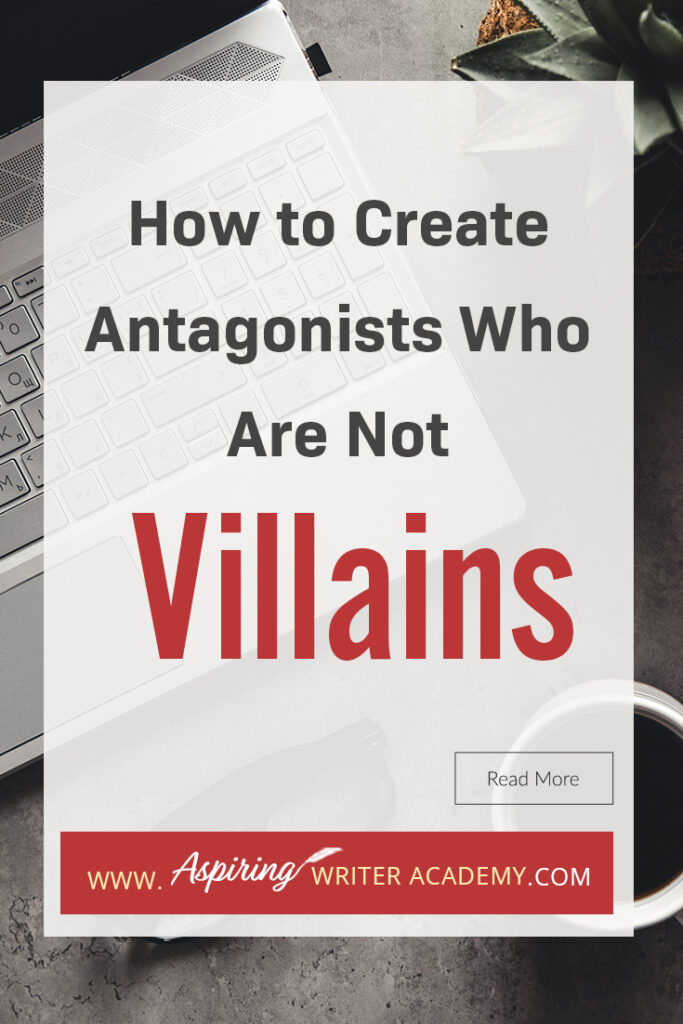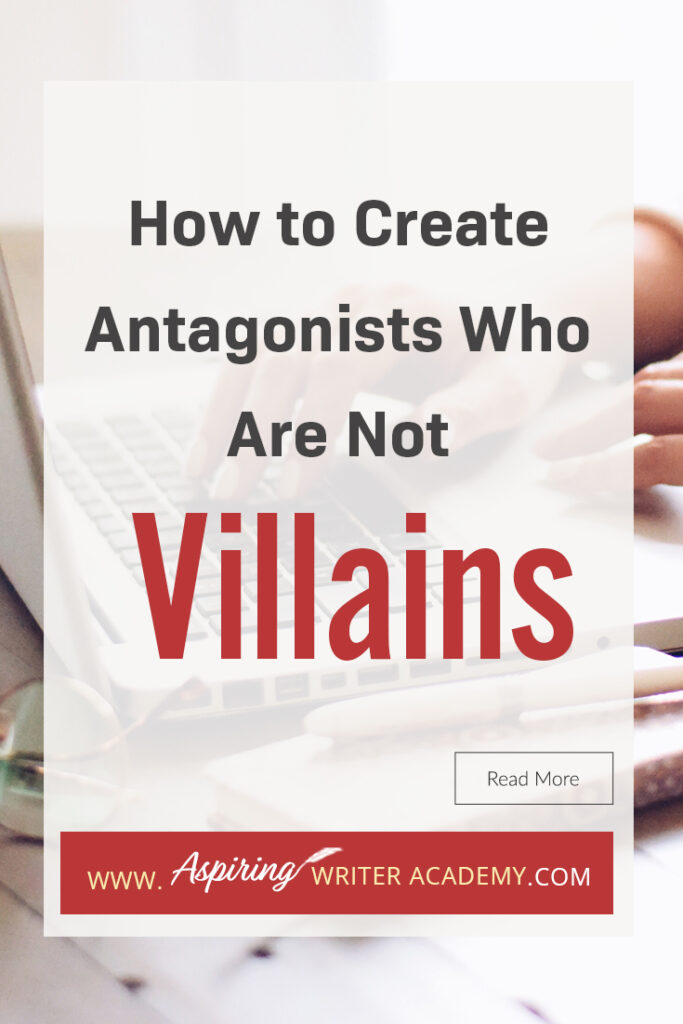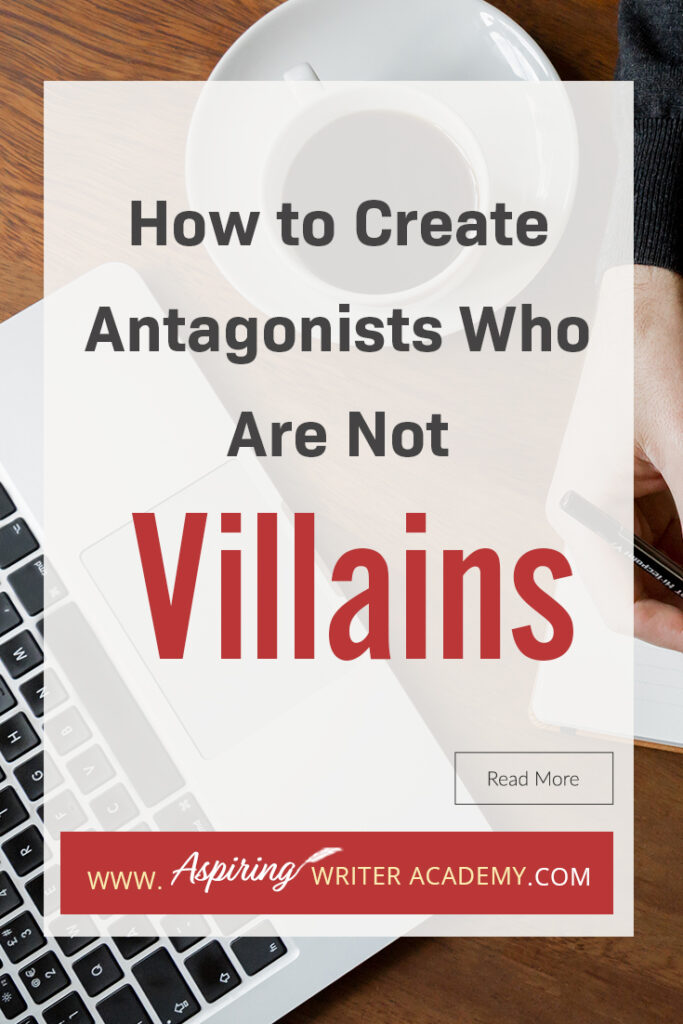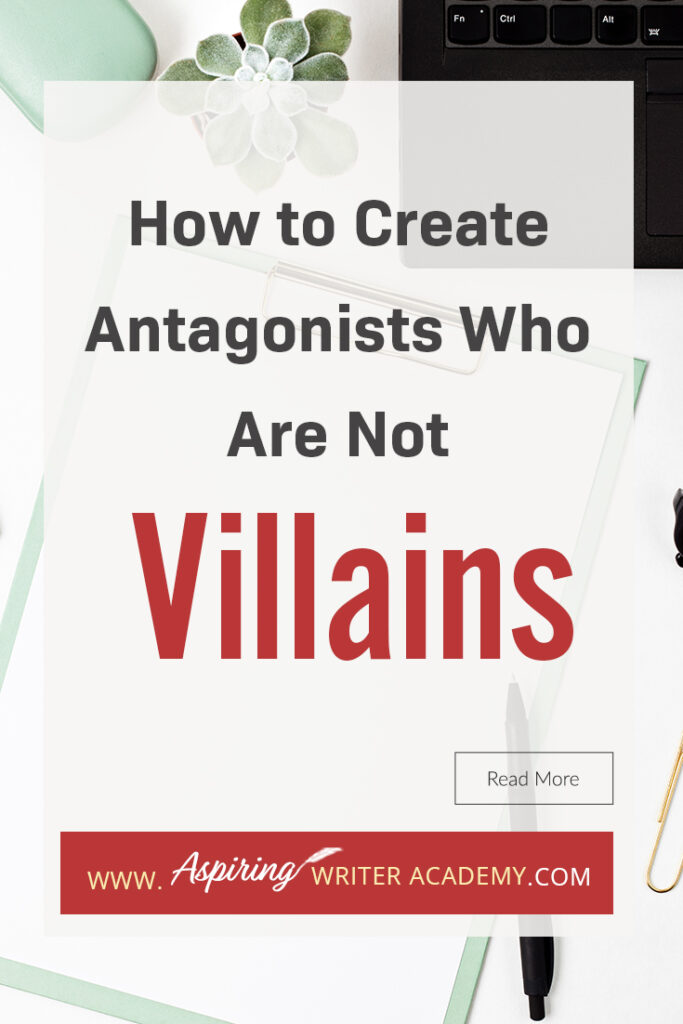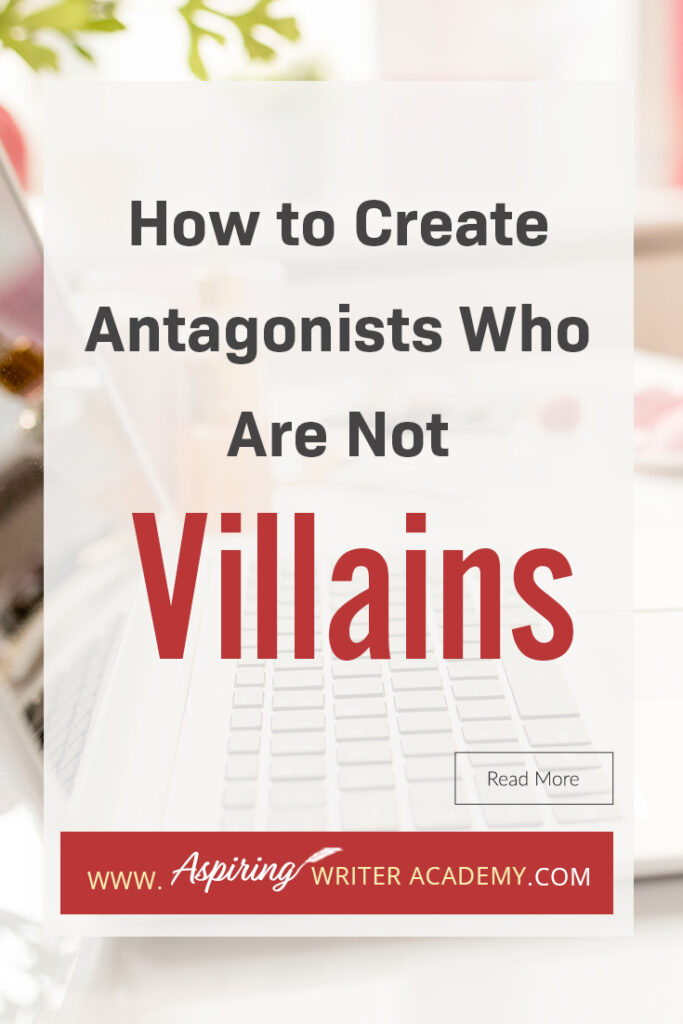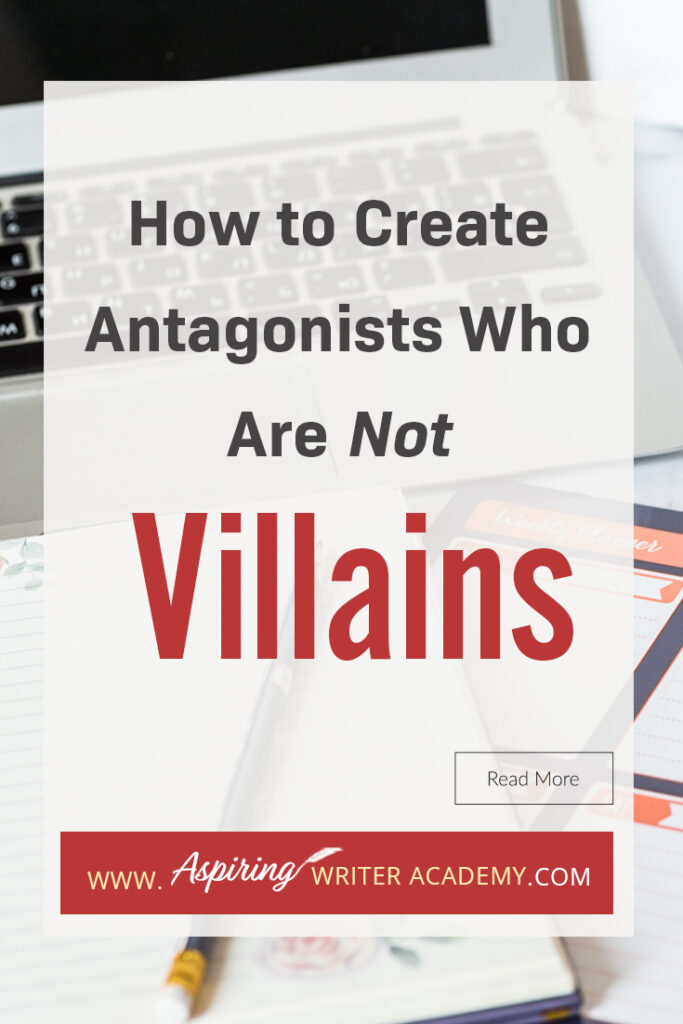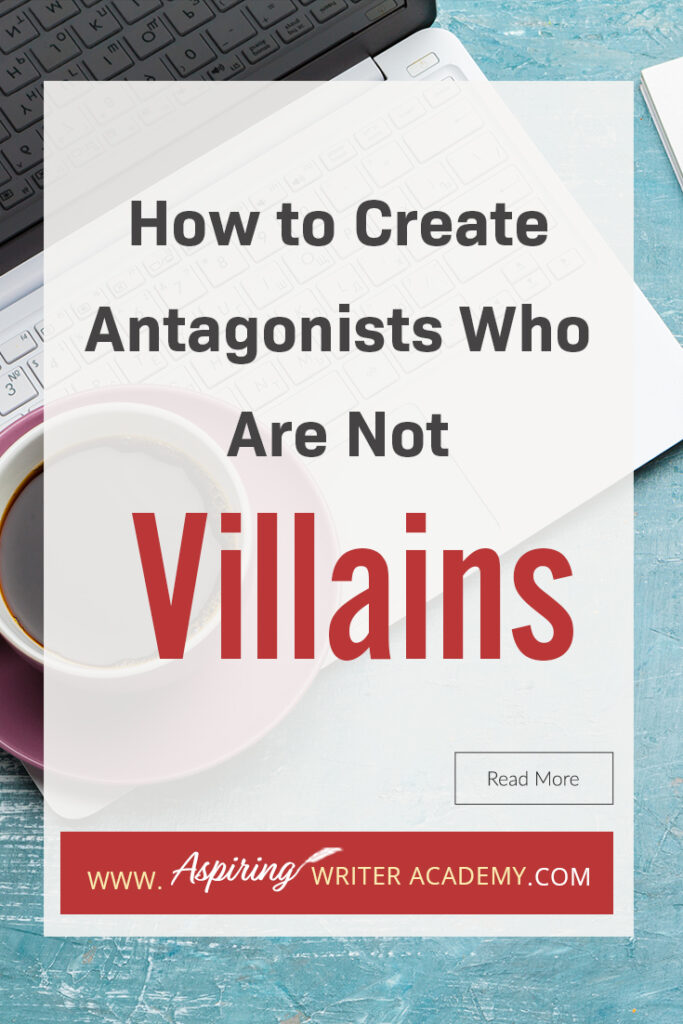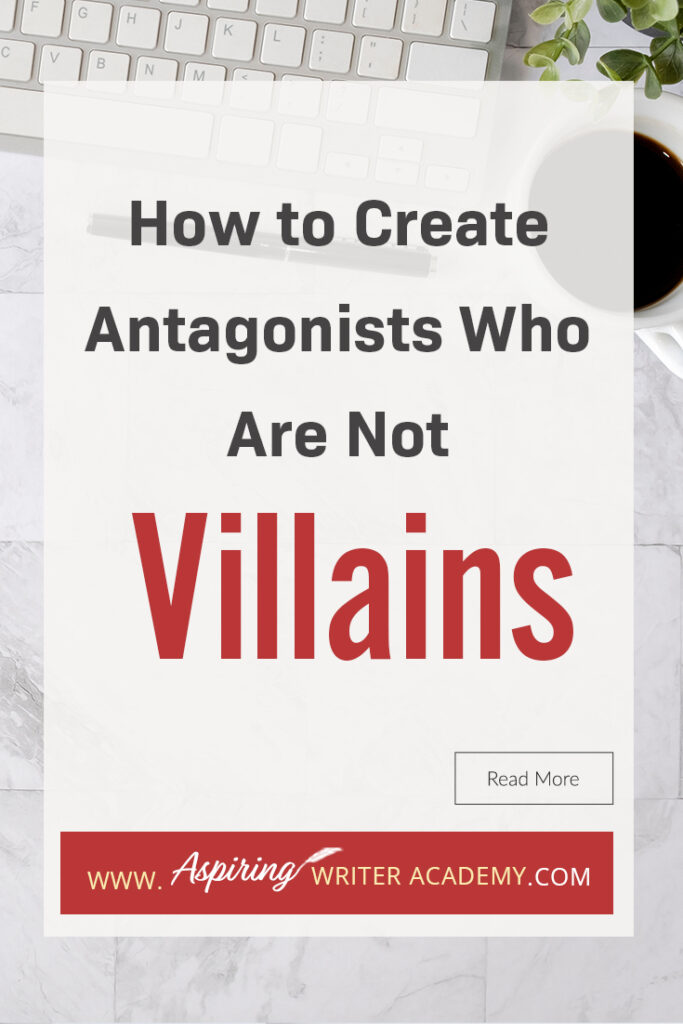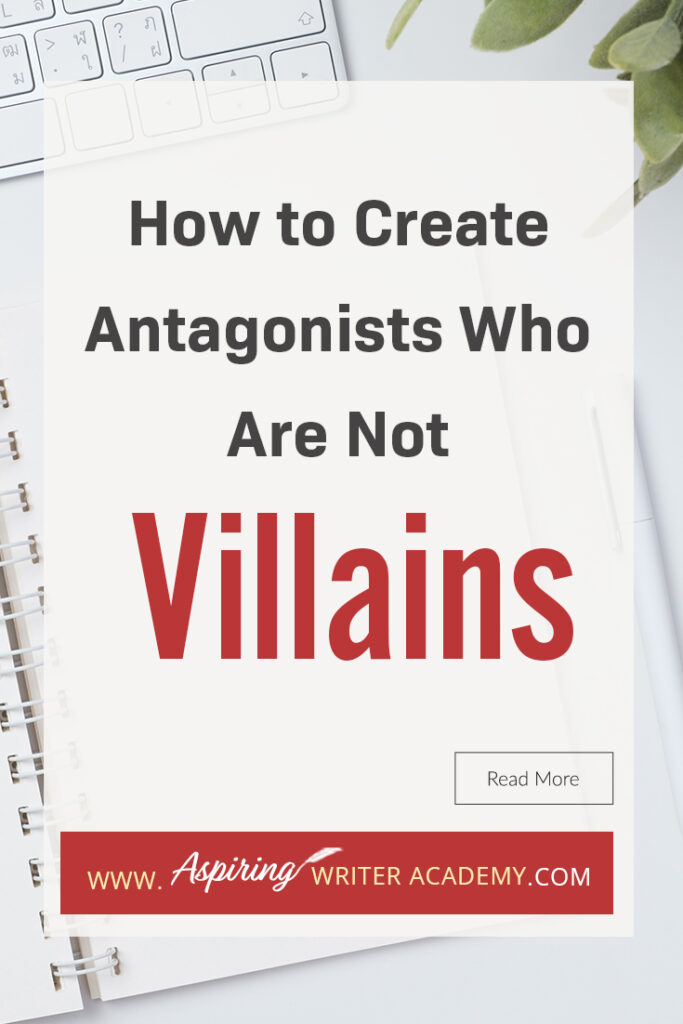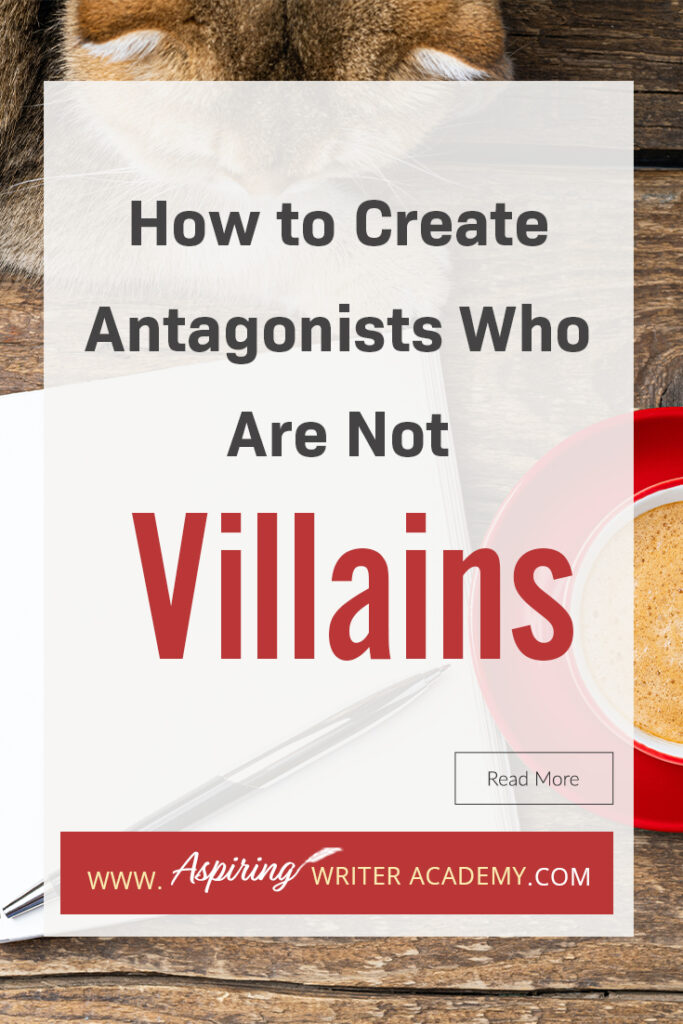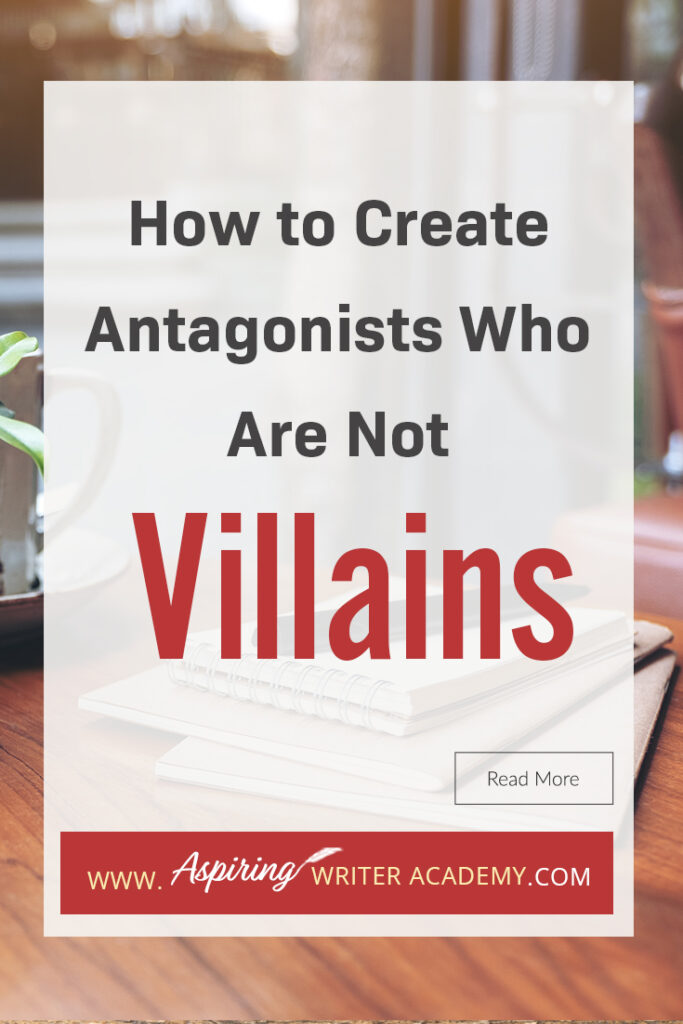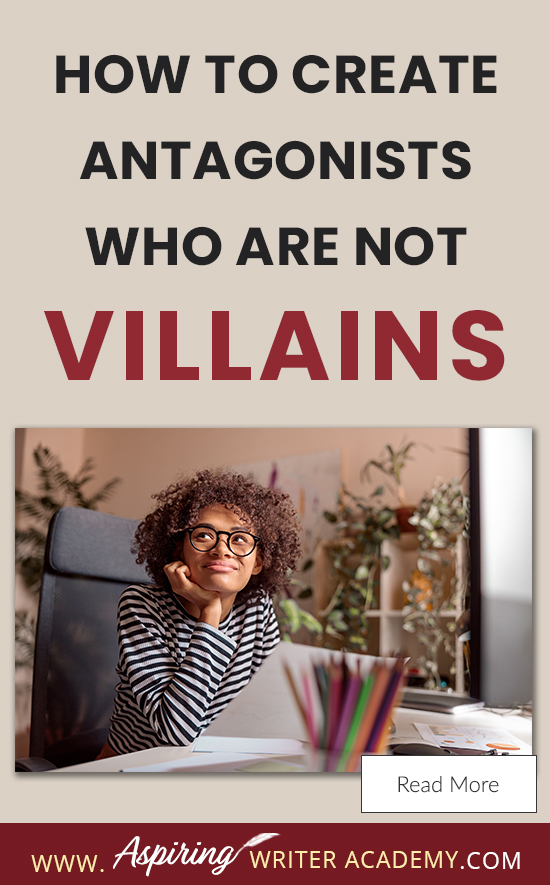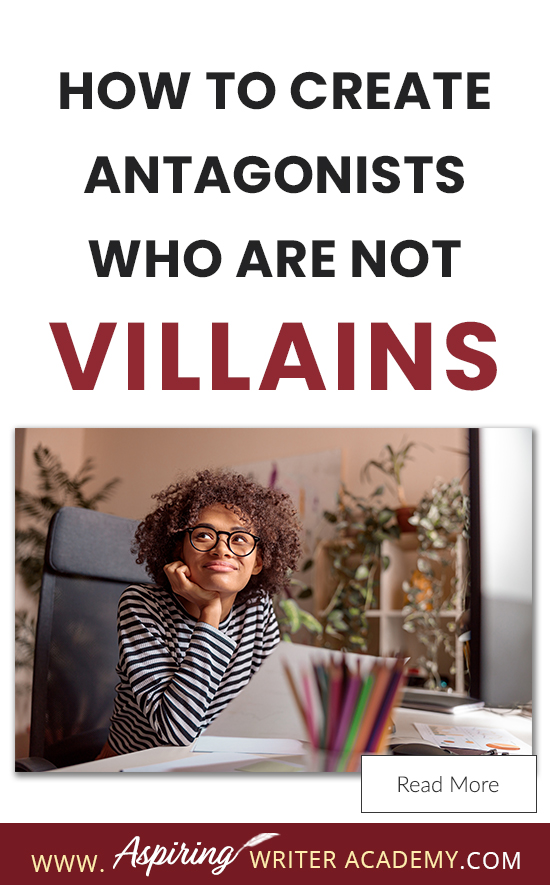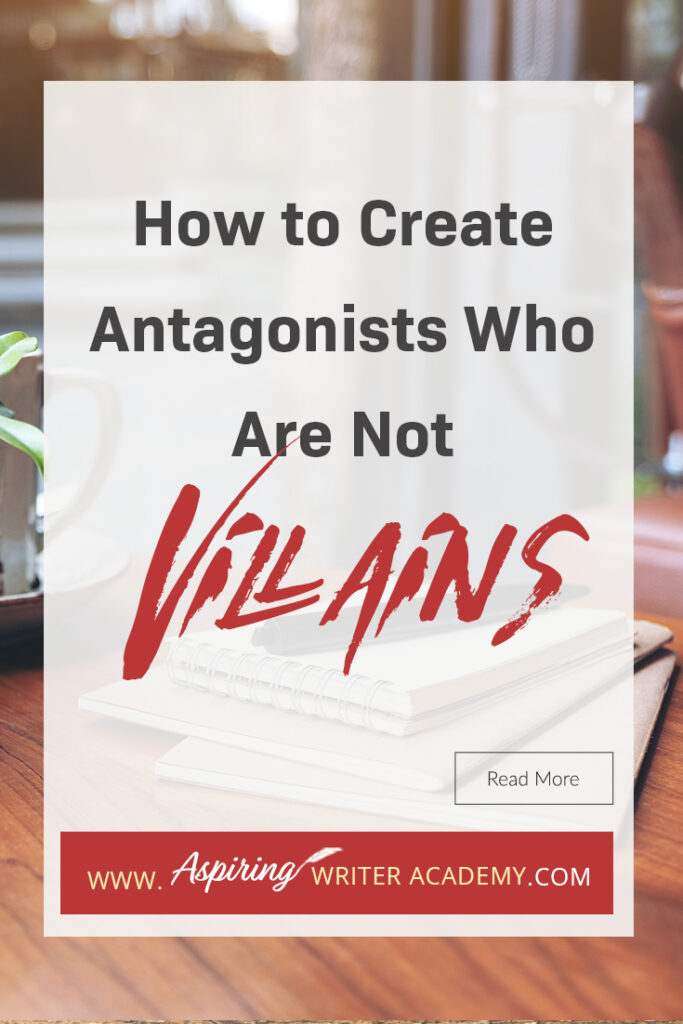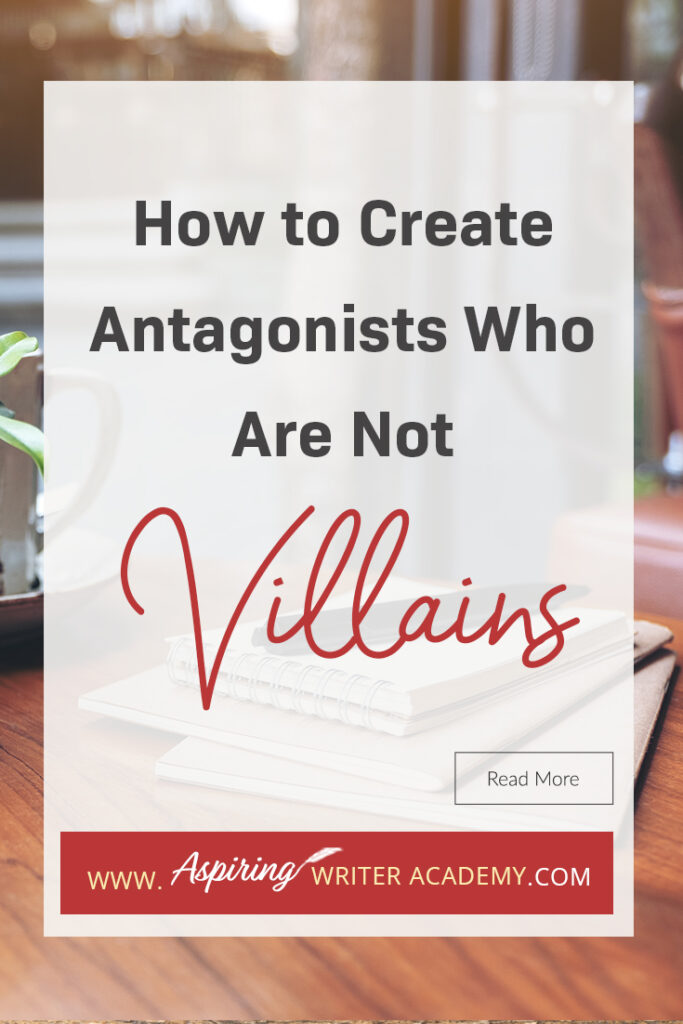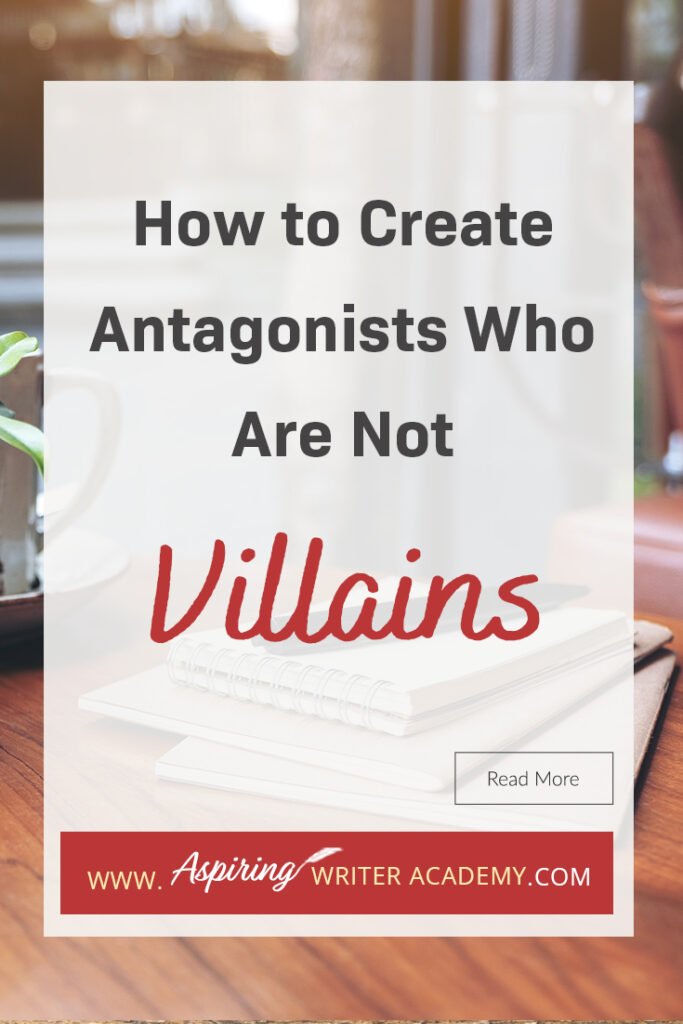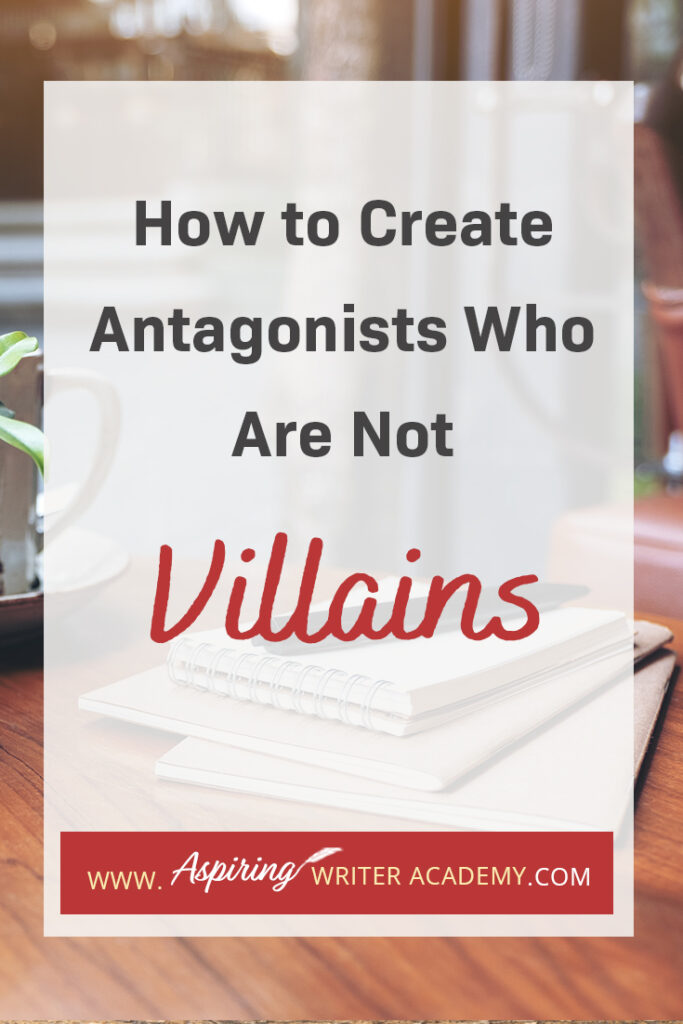How to Create Antagonists Who Are Not Villains
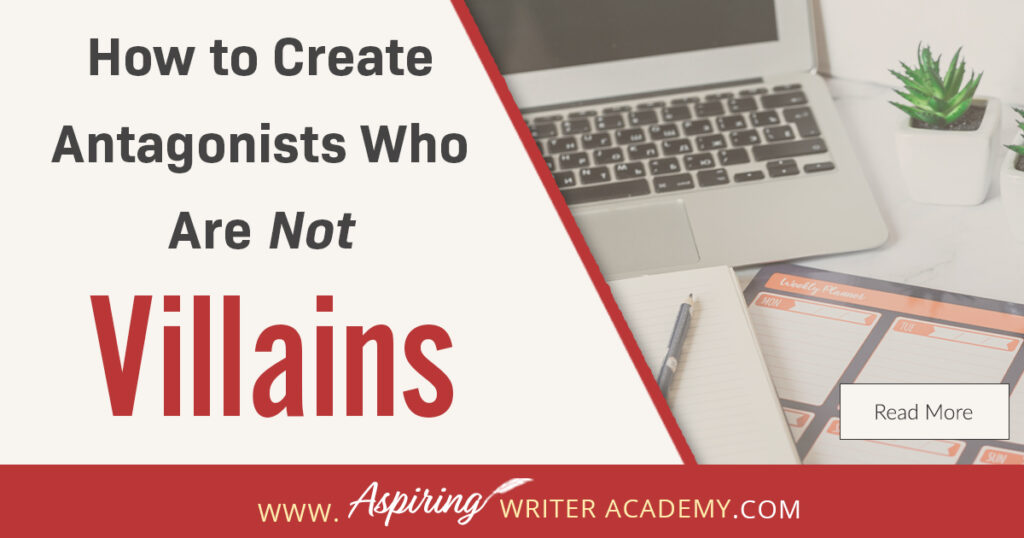
A good fictional story will follow the journey of a main character (protagonist) who is trying to achieve a specific goal. The opposition, (or antagonist), will try their best to stop the main character from achieving that goal. The question is why?
What if each point of view is equally valid? What if the antagonist is not a villain?
In our post, How to Create Antagonists Who Are Not Villains, we show you how to write realistic conflict that will intensify your fictional novel.
Follow along as we discuss:
- The role of an antagonist
- The difference between antagonists and villains
- Goals and motivation
- Unresolved conflict
- Finding a resolution
You may also want to download our How to Create Antagonists & Villains Workbook with fill-in-the blank templates for $5.99.
1) The role of an antagonist
- An antagonist opposes the main character (protagonist) and creates conflict.
Another name for antagonist is ‘opposition.’ The antagonist opposes the main character’s goal and tries to stop him. This creates conflict.
Example:
If the main character’s goal is to live a quiet, simple life, the antagonist is going to do something that disrupts that way of life. If the main character does not find a way to overcome this opposition, or defeat this antagonist, or find a solution to the conflict the antagonist presents, his life will never be the same again.
Even if the conflict is from a group of people, you will want one person to stand out as the head or leader or “face” of that group. One main antagonist. Other sub-characters who help the antagonist may be his minions.
- The antagonist forces the main character to make a decision.
Within the beginning chapters of your story, after the story world is set up, the antagonist takes action upon the main character and presents him with a big story problem. This is called the Inciting Incident. This is a devasting blow to the protagonist.
It is the antagonist who instigates the main story conflict. The antagonist’s actions drive the protagonist to make a decision on how to deal with or overcome the major conflict (big story problem).
The protagonist cannot ignore or walk away from this serious problem. It must be dealt with head-on or his life, and possibly the lives of others, will never be the same. The consequences are dire.
What will he do?
- The antagonist forces the protagonist to take action.
Dealing with the serious problem presented by the antagonist will force the main character (protagonist) out of his comfort zone.
Example:
In the Disney movie, Toy Story, life is just fine for the cowboy doll, Woody, until a new toy comes into the house, an arrogant astronaut action figure named Buzz Lightyear, who replaces Woody as the boy’s favorite. Now if Woody can not find a way to overcome the opposition (Buzz Lightyear) his life will never be the same again! Finding ways to try to defeat his new rival will be challenging.
The protagonist will choose a story-worthy goal (an action plan which can be broken down into several smaller steps) to overcome the opposition. Achieving this goal will not be easy. The protagonist may need to learn a new skill or gather a team to help him.
The antagonist does not just create conflict once but continues to oppose the protagonist throughout the entire story in a stimulus-response fashion.
For every step forward the protagonist takes to reach his goal, the antagonist responds by either blocking that step, forcing the protagonist to take a new step or a step back. Much like a game of chess or tug-of-war, the protagonist and antagonist battle it out until the story’s conclusion.
- The antagonist’s opposition helps the protagonist change and grow.
The ongoing conflict between the protagonist and antagonist throughout the story helps the main character gather new insight, change, and grow.
The growth can be internal as the protagonist comes to see a new perspective or adopts a new belief. Or the change can be physical, as the character gains the skills and ability to do things he couldn’t do before. Maybe a combination of both.
The conflict challenges and develops the protagonist’s character which may lead him to change for the better mentally, spiritually, and physically.
Looking for an easy way to organize your thoughts? We invite you to download our How to Create Antagonists & Villains Workbook with fill-in-the-blank templates for $5.99 to help you create worthy opposition for your main character.
2) The difference between antagonists and villains
- An antagonist may be a villain. Both create opposition and conflict.
An antagonist may be a real villain, someone with evil motives, one who lacks morals and purposefully seeks to harm others. A villain does not usually learn anything to help him change or grow. In fact, a villain’s capture, demise, or downfall at the end of a story can illustrate what can happen when someone does not learn a particular life lesson.
Or
- An antagonist may simply be someone who presents opposition. This kind of antagonist can even be a beloved family member or best friend or romantic interest. An antagonist who is not a villain may be just as honorable, likeable, and skilled as the protagonist.
This is often seen in a romance where both the hero and heroine are fighting to obtain the same thing, such as the ownership to a specific ranch.
Or the opposition may come in the form of opposing views. A mother may think she knows what is right for her daughter, but her daughter thinks differently.
Many times, when the antagonist is not a villain, it seems the story has two main characters. However, only one will truly be the protagonist. Usually, the one who has the most to lose or the one who experiences the most change.
And unlike villains, an antagonist who merely presents opposition can experience change and growth in the story (the same as your main character) which may eventually lead to a peaceful resolution.
3) Goals and motivation
Some of the best conflicts are created by an antagonist who is just as likeable and has almost as much to lose as the main character. Like two dogs fighting for the same bone, two characters may simply be fighting against one another to gain hold of the same asset.
Or they might hold opposing views, such as what is best for a child, school, town, or country. Both protagonist and antagonist believe in what they hold to be right and true and are willing to “go to war” and fight for it. The stakes for winning must be high, the consequences of failure must be considered devastating or unthinkable for each of them.
Both protagonist and antagonist will need strong motivations for their beliefs and their actions.
- Why is the goal so important? What does it mean for each of them? What do they each have to gain?
- How does this tie-in to their backstory? What happened in the past to make them each form the beliefs that drive them?
- Why is failure to achieve their goal unthinkable? What do they each have to lose?
Make it matter. Make it hurt. The higher the stakes and the more dire the consequences, the more intense the conflict. Keep your reader turning those pages!
4) Unresolved conflict
The protagonist and the antagonist must both have valid reasons to fight for their goal. It should not seem likely either one will compromise. Their opposing wants or beliefs or point of views run too deep. The battle ensues as they both take action to get what they want.
If something doesn’t change, the conflict will never be resolved. Either one party needs to get the better of the other party and defeat him, or some new insight needs to be revealed that causes change and instigates a willingness to compromise.
The opposing conflict may run through the entire story with one winner revealed at the end.
Example:
Two individuals fighting against one another in a court case. Both present evidence key to defending their view. However, in the end, the judge or jury will decide who wins.
If the story focuses on a war where both sides take strides to defeat the other, one will undoubtedly gain the upper hand and win in the end.
Or the opposing conflict may change halfway through the story at the midpoint, when one or perhaps both characters gain insight into the situation which causes them to have a change of heart. At this point the characters may realize they must come together to fight against an even greater foe. A greater conflict is introduced that may force them to put their own personal differences aside until the resolution at the end.
Warning: Story Spoiler Alert for the movies used as examples below.
Example:
Halfway through the romantic comedy, You’ve Got Mail starring Tom Hanks and Meg Ryan, the Tom Hanks character discovers that the small bookstore his big corporate bookstore chain is trying to put out of business is owned by “Shopgirl,” a woman he’s fallen in love with online. If she were to find out, she would never forgive him.
This changes things for the Tom Hanks character, and his goal shifts, as he realizes they will never be happy together unless he can convince her love to him despite his role in taking down her store.
The first half of the movie he is trying to defeat her store, the second half of the movie he is trying to win her heart so that when she does find out the truth, she might somehow forgive him. He succeeds in achieving his first goal, but he will only be happy if he can achieve the second goal, which he now deems as more important.
Another Example:
In the movie, Passengers, Jim wakes up from a deep sleep, decades too soon, as he and thousands of others travel to make a new home on a new planet. He is lonely and although he knows it is morally wrong, he intentionally tampers with a young woman’s sleep pod and wakes her up too. The only problem is that by doing so, he is dooming her to also die with him on that spaceship, robbing her of a life one day on that other planet.
When Aurora finds out what he has done halfway through the movie, she is furious. She never would have forgiven him if something didn’t happen to create change. But when another malfunction awakens the Captain, and they discover the entire spacecraft and all its passengers are in grave danger, Aurora and Jim must put aside their feud and work together to fix the ship or they all will die.
Because they work together during the second half of the movie, they learn they need each other and change and grow as individuals. Then at the end of the story, Jim gains the capabilities to fix Aurora’s sleep pod and make things right for her—if she chooses. However, she too has gained new insights and her values have changed, and she gives up her original goal for a new goal of living her best life with him.
One More Example:
Going back to the movie, Toy Story, it seems that cowboy Woody and action figure Buzz Lightyear would never have worked out their back-and-forth rivalry if something did not change at midpoint.
But halfway through the story, the boy’s family moves to a new house and both Woody and Buzz are accidentally left behind. Now they must lay aside their differences and work together for the second half of the story to escape the clutches of their ruthless neighbor and reunite with their boy. Because of the trials they go through in trying to defeat the new larger threat, they learn to work out their differences and reconcile by the movie’s end.
5) Finding a resolution
Whether or not your protagonist and antagonist fight against each other the entire story or whether they set aside their differences for a while to fight against a greater foe, in the end, they still need to find a resolution to the conflict between them.
Resolutions can come from the introduction of new information (as long as it is believable and organic to the story), or epiphanies leading to a change of heart, giving the characters the desire to work on a compromise or even sacrifice what they once held dear for one another.
- New Information.
Resolution can come from an epiphany or gained insight or knowledge one didn’t know before. Or the protagonist has a new skill he hadn’t mastered before…until now.
Examples:
After following multiple clues throughout the quest, the protagonist has gained the skills to unlock a code enabling him to find the hidden treasure buried deep in the mountain.
The protagonist may discover the antagonist’s flaws or weaknesses, perhaps a secret, and uses that knowledge to gain the upper hand and win in the climactic battle at the end of the story.
After a long, embittered struggle, justice is served when the protagonist finds a key witness that can help him win the court case against a resentful conveyor of lies.
- Compromise.
Resolution can also come from a change of heart leading to compromise.
Story events can lead a character to have a change in perception of what is important. A change in character, in turn, changes the relationship.
The theme of the story usually comes out of the events or challenges used to test the character and cause them to change and grow.
Examples:
Two former rivals fighting to gain dominance over a kingdom, may unite to run the kingdoms together.
One character may agree to give up the deed to her ranch in exchange for a coveted share of stocks that are predicted to soar.
Two divorced parents fighting over child custody may find a way to work out raising their children together. Maybe they buy houses in the same neighborhood so the children can remain in the same school system.
- Sacrifice.
At the end of the story, one may value something else more than the original goal. Or give up their goal for what they now see and believe is a better one. The characters wouldn’t have changed or come to this insight if it weren’t for the conflict and story journey.
Examples:
After an event or escalation of events gets out of control, one may realize the fight isn’t worth losing something else, like a relationship.
One character may be in a position to win the fight over the other, maybe has everything he needs to take her ranch, but because he’s fallen in love with her, he sacrifices his own company, selling it to another, in order to get the money to let her win and keep the ranch. Why? Because his love for her is now stronger than his desire to win. He values love over monetary gain or accumulation of assets.
Maybe because of the story events that unfold during the conflict, one character may have a change of heart and switch over to the other side, supporting the other character’s views. Two rival protestors may suddenly find themselves on the same side. Because of the story events that led to new insight, one gave up his belief for a belief he now deems is better.
Again, we invite you to download our How to Create Antagonists & Villains Workbook with fill-in-the-blank templates for $5.99 to help you create worthy opposition for your main character.
We hope you have enjoyed How to Create Antagonists Who Are Not Villains and that you have gained some valuable insight into what creates conflict and how to use it to intensify the character relationships in your fictional novel.
If you have any questions or would like to leave a comment below, we would love to hear from you!
If you like more help developing your story, you may wish to download our Free Brainstorming Your Story Idea Worksheet
Our Goal for Aspiring Writer Academy is to help people learn how to write quality fiction, teach them to publish and promote their work, and to give them the necessary tools to pursue a writing career.

ENTER YOUR EMAIL BELOW
TO GET YOUR FREE
"Brainstorming Your Story Idea Worksheet"
7 easy fill-in-the-blank pages,
+ 2 bonus pages filled with additional story examples.
A valuable tool to develop story plots again and again.
Other Blog Posts You May Like
Scene & Sequel: The Secret to Plotting an Epic Novel
Scene & Sequel: The Secret to Plotting an Epic Novel (Part 2)
Writing Fiction: How to Develop Your Story Premise
12 Quick Tips to Write Dazzling Dialogue
10 Questions to Ask When Creating Characters for Your Story
Macro Edits: Looking at Your Story as a Whole
Basic Story Structure: How to Plot in 6 Steps
Writing Fiction: How To Keep Track of Time in Your Story
Behind the Scenes: Interview with the Authors of the “Sew in Love” Collection

is a multi-published author, speaker, and writing coach. She writes sweet contemporary, inspirational, and historical romance and loves teaching aspiring writers how to write quality fiction. Read her inspiring story of how she published her first book and launched a successful writing career.

